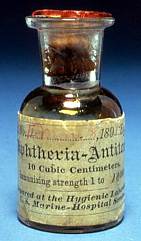 (source)
(source)
|
Hermann M. Biggs
(29 Sep 1859 - 28 Jun 1923)
American physician who was New York City's Public Health Officer and pioneered the use of bacteriological studies in the field of public health for the prevention and control of contagious diseases.
|
The New Treatment of Diphtheria
From The Century Magazine (Jan 1895)
by Hermann M. Biggs

The new anti-toxine treatment of diphtheria promises to prove one of the most important developments of modern medicine, and seems to represent, in a particularly practical and valuable form, the best results of recent bacteriological investigations as to the nature of the infectious diseases. I use the word “development” advisedly in this connection, for the new treatment is not by any means the result of a single empirical observation, or a conclusion reached from a single series of experimental investigations, but is the necessary and logical deduction and practical result arrived at from many series of experimental investigations regarding the infectious diseases. These investigations have been going on for the last seven or eight years, and in order to gain any intelligent conception of the nature of the new treatment, one must know something of the work that has preceded it.
In the early days of modern bacteriology, it was thought that the germs associated with the various diseases were themselves the essential and active agents in the production of the symptoms presented. It was not until the subject had been more deeply investigated that evidence was found to show that the chemical products of bacterial life were really the cause of most of the symptoms characteristic of the different infectious diseases; and that in respect to many of these diseases the chemical poisons could be separated from cultures of the germs grown outside the body. It was further found that when the chemical poisons separated from such cultures were used for the inoculation of animals, not infrequently the same constitutional symptoms were produced as occurred when the germs themselves were introduced, or when the diseases occurred under natural conditions.
It has been long known that in many infectious diseases one attack grants a more or less complete insusceptibility or immunity to future attacks. The same individual rarely has two attacks of smallpox or of scarlet fever, because the first attack has given a nearly complete immunity from the disease. In some infectious diseases the immunity acquired from a single attack is permanent; in others it is only temporary, lasting for a few months, or sometimes perhaps a few years.
Investigations have shown further that the immunity acquired both by animals and man from once having suffered from an infectious disease is at least frequently, if not always, the result of the development in the blood of the individual of some chemical substance (which it has not yet been possible to separate or isolate chemically) that has the power of neutralizing both outside and inside the living body the poison produced by the germs causing that particular disease. Experimental investigations, which have been going on for four or five years, have shown that animals inoculated with the chemical poison or toxine separated from cultures of the diphtheria germ gradually become more and more tolerant of this poison, and finally enormous quantities, many times the fatal dose, may be introduced without causing anything but a temporary disturbance. As the animals become more insusceptible to the action of the poison, the blood acquires to a larger degree the power of neutralizing the poison. It has been further shown that this neutralizing power is due to the formation in the blood of an anti-toxine. When the serum of the blood of animals which have been thus rendered immune to diphtheria is mixed with solutions containing the toxine outside the body, these solutions are deprived of Their poisonous property; and when the serum is introduced in sufficient amount underneath the skin of animals, they become insusceptible not only to the action of the toxine of diphtheria, but also to the diphtheria germs themselves; and finally, when used in animals or human beings already suffering from diphtheria, it neutralizes the poison, and cuts short the disease.
In diphtheria death is very commonly due to the action upon the heart or some of the other organs or tissues of the body of the diphtheria poison or toxine which has been absorbed from the throat. The blood serum of animals that have been rendered insusceptible to diphtheria neutralizes the diphtheria poison in the circulation, and so protects the individual from its deleterious action. It acts as a true specific. It has been found possible in this work accurately to determine the degree of toxic properties of various solutions of the diphtheria poison, and also accurately to determine the value of the blood serum derived from animals which have been rendered immune to diphtheria. Thus a standard of dosage can be easily fixed.
The investigations thus far made would seem to show in the most unmistakable manner that this blood serum, or curative serum as it is called, constitutes almost a certain and specific cure for diphtheria when employed early in the course of the disease; and that almost all persons who are subjected to treatment within the first two or three days recover, whereas before this treatment was instituted, or where it has not been used, the mortality from this disease among children under five years of age has varied from forty to fifty percent. or more.
Unfortunately, the production of the curative serum is difficult and expensive. From four to ten months are necessary sufficiently to immunize large animals such as horses, cows, or goats, which are chiefly employed; and the work requires the constant attention of thoroughly trained men. At present this remedy cannot be obtained in this country, or at least only in the smallest quantity and at great expense; and so, although science has provided what seems to be a specific for one of the most dreaded and fatal of diseases, yet it must be some months at least before most persons suffering from diphtheria will be able to avail themselves of its use. The New York City Health Department has asked for a special appropriation for the maintenance of a research laboratory one of the chief functions of which will be the production of the diphtheria anti-toxine; and if this appropriation is granted, it is hoped that before many months the new remedy may be obtained in abundance.
Finally, it may be said that the importance of the diphtheria anti-toxine, or curative serum, in the prevention and treatment of diphtheria can scarcely be overestimated. The remedy has already passed the experimental stage, and its value and efficacy have been thoroughly established. In proper cases it is not only an almost certain cure for diphtheria, but is also apparently an entirely reliable agent for the prevention of this disease, while under all conditions it is absolutely harmless.
The results thus far obtained have been most remarkable. The mortality from diphtheria in children under five years of age has been reduced by the use of anti-toxine in suitable cases from 50 or 60 per cent. to from 10 to 20 per cent. During September the mortality in the hospitals of Berlin was reduced by this treatment to 11 per cent. In October the supply of anti-toxine was exhausted, no more could be obtained, and immediately the mortality increased to nearly 60 per cent.— the previous rate.
The influence of the use of this agent on the death-rate from diphtheria in Paris constitutes in my opinion an exhibit of the saving of life by a new remedy so extraordinary as to be without a parallel in the history of medicine. In the fourth week of September the deaths from diphtheria in the whole city of Paris, with 2,500,000 inhabitants, numbered only two; and in the month of October the mortality for the city to the 27th inst. was only twenty-three.
No such result has ever before been obtained. It seems entirely probable that through the influence of the anti-toxine on the prevention and cure of diphtheria, this disease may eventually be brought completely under control.
Hermann M. Biggs.
- Science Quotes by Hermann M. Biggs.
- 29 Sep - short biography, births, deaths and events on date of Biggs's birth.
- 9 Sep - first diagnostic public heath laboratory in U.S. opened in New York City.
- 13 Dec - first tuberculosis community laboratory in U.S. opened in New York City.
- The Public Health Service and the Control of Biologics - John Parascanola writes about the early production of diphtheria anti-toxin, and the associated problems with contamination. (pdf)
- A Short History of the National Institutes of Health - Biologics
- Childhood's Deadly Scourge: The Campaign to Control Diphtheria in New York City, 1880-1930, by Evelynn Maxine Hammonds. - book suggestion.




